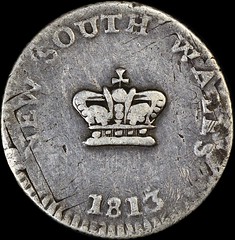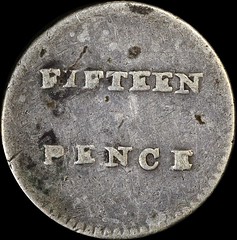
PREV ARTICLE
NEXT ARTICLE
FULL ISSUE
PREV FULL ISSUE
HOLEY DOLLAR AND DUMP: MEASURE TWICE, CUT ONCEAustralian dealer Andrew Crellin posted a nice article recently on his Sterling & Currency company blog about the important calculations behind the creation of the Holey dollar and Dump coins for New South Wales (NSW). -Editor   What is often overlooked in that assessment is the fact that the way the Dump was cut and struck determined whether both coins remained in circulation. If Macquarie’s counter-stamping plan was to prevent coins from being taken outside NSW, the weight of both the Holey Dollar and the Dump needed to fall within a tightly defined range. If either coin weighed outside their intended range, its silver value could vary widely from its face value, which could be an incentive to take the coin away from NSW and pass it off at its intrinsic value, defeating the purpose of the whole exercise. All other criteria being equal, the weight of each Dump (and thus the weight of each Holey Dollar it was cut from) was determined by the diameter of the Dump. The larger the diameter of a Dump, the heavier it is; and also the lighter the Holey Dollar it was cut from. If the weight of each coin was to be within a tolerance that enabled the currency value of both coins to exceed its intrinsic value, Henshall needed to calculate the diameter of the Dump very precisely. To read the complete article, see: Wikipedia has a decent overview of the origin of Holey Dollars and dumps. -Editor Holey dollar is the name given to coins used in the early history of two British settlements: Prince Edward Island (now part of Canada) and New South Wales (now part of Australia). The middle was punched out of Spanish dollars, creating two parts: a small coin, known as a "dump" in Australia, and a "holey dollar". This coin was one of the first coins struck in Australia. To read the complete article, see:  Wayne Homren, Editor The Numismatic Bibliomania Society is a non-profit organization promoting numismatic literature. See our web site at coinbooks.org. To submit items for publication in The E-Sylum, write to the Editor at this address: whomren@gmail.com To subscribe go to: https://my.binhost.com/lists/listinfo/esylum All Rights Reserved. NBS Home Page Contact the NBS webmaster 
|